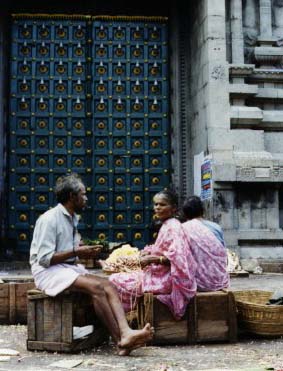 Wednesday, November 27:
Wednesday, November 27:
Return to Madras
I still wasn't feeling too great, but I was well enough to travel back to Madras. There was an extended break in the rain that morning, so we hired a taxi. The two hour ride back to Madras was smooth and comfortable. This was to be our last night's stay in India, so we decided to splurge and make it a comfy one. We stayed at the Ambassador Pallava Hotel, one of Madras' flagship four-star hotels. Though it was quite lavish by Indian standards, in retrospect I'm not sure if it would have been worth $100 in the states, but after some of the places we had stayed over the last 21 days, it was well worth it at that moment in time.
 We chilled out in the room and at the hotel cafe before heading out to the Sri Kapalashwaram temple. An autorickshaw took us to the temple, which was no more than 10 minutes away. It was a typical Dravidian gopuram-style temple, shooting up into the sky like a tall Remington Microscreen electric shaver. The temple was adorned with thousands of brightly painted statue miniatures, which gave it the appearance of a cross between a Grateful Dead album cover and a Heironymous Bosch painting. The rains had departed for a few hours, but the clouds made it difficult to get any pictures. We also weren't allowed inside the temple (Hindus only), so after 15 minutes or so, we were ready to move on to our next stop, Fort St. George.
We chilled out in the room and at the hotel cafe before heading out to the Sri Kapalashwaram temple. An autorickshaw took us to the temple, which was no more than 10 minutes away. It was a typical Dravidian gopuram-style temple, shooting up into the sky like a tall Remington Microscreen electric shaver. The temple was adorned with thousands of brightly painted statue miniatures, which gave it the appearance of a cross between a Grateful Dead album cover and a Heironymous Bosch painting. The rains had departed for a few hours, but the clouds made it difficult to get any pictures. We also weren't allowed inside the temple (Hindus only), so after 15 minutes or so, we were ready to move on to our next stop, Fort St. George.
The fort was set up by the British in the early 1600s, and was the Crown's first outpost on Indian soil. It's still used today as a military and state administrative complex, and because of all the hustle and bustle, the fort felt more like a modern military base than a piece of Raj history. The fort's museum was a ragged display of British weapons, uniforms and documents. Upstairs, though, we found an old ballroom that had been converted in to a portrait hall. 20 large paintings of former monarchs and local Maharajas filled the walls, including a rather famous portrait of a young Queen Victoria. A few buildings south of the museum, we entered St. Mary's Church, the oldest Anglican house of worship east of the Suez. It was a simple stone church with wooden pews and dozens of small marble plaques and memorials, including one to Elihu Yale, former governor of Madras, as well as the eventual founder of Yale University.
Somehow the day had flown by, and it was getting late. The sun was bearing down on my weary body, so I went back to the hotel and rested. It was an anticlimactic last night in India, but I figured I better rest for a healthy trip back and a fun overnight stay in Amsterdam.
 We chilled out in the room and at the hotel cafe before heading out to the Sri Kapalashwaram temple. An autorickshaw took us to the temple, which was no more than 10 minutes away. It was a typical Dravidian gopuram-style temple, shooting up into the sky like a tall Remington Microscreen electric shaver. The temple was adorned with thousands of brightly painted statue miniatures, which gave it the appearance of a cross between a Grateful Dead album cover and a Heironymous Bosch painting. The rains had departed for a few hours, but the clouds made it difficult to get any pictures. We also weren't allowed inside the temple (Hindus only), so after 15 minutes or so, we were ready to move on to our next stop, Fort St. George.
We chilled out in the room and at the hotel cafe before heading out to the Sri Kapalashwaram temple. An autorickshaw took us to the temple, which was no more than 10 minutes away. It was a typical Dravidian gopuram-style temple, shooting up into the sky like a tall Remington Microscreen electric shaver. The temple was adorned with thousands of brightly painted statue miniatures, which gave it the appearance of a cross between a Grateful Dead album cover and a Heironymous Bosch painting. The rains had departed for a few hours, but the clouds made it difficult to get any pictures. We also weren't allowed inside the temple (Hindus only), so after 15 minutes or so, we were ready to move on to our next stop, Fort St. George. Wednesday, November 27:
Wednesday, November 27:

